LIVING RITUALS – EXHIBITION PARCOURS
A tour through seven selected studios
A jury has selected seven studios from the 100 artists participating in the Open Studio Days, in which artists have explored the theme of “Living Rituals”. Take an online tour of the curated studio presentations and read about the artists’ working methods and world of thought. Photographer Sandro Zanzinger provides rare glimpses into artistic creative spaces.
During the Vienna Art Week online talks with the artists of the LIVING RITUALS Exhbition Parcours took place, which can be viewed via the direct links.
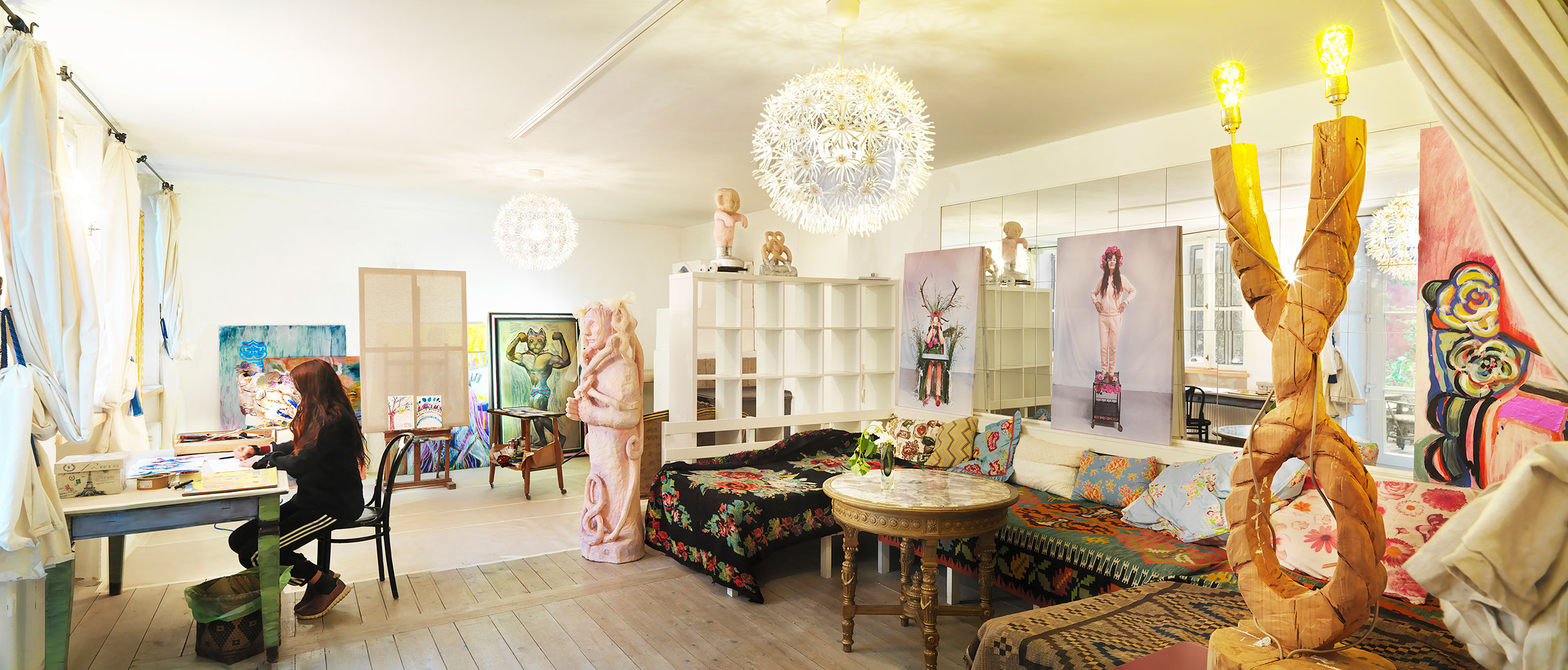 Studio Elisabeth von Samsonow © Sandro Zanzinger
Studio Elisabeth von Samsonow © Sandro Zanzinger
ELIZABETH VON SAMSONOW
“For me, rituals are the great magical arrangements of action, the metaphysics of the body. Cultural studies has declared all sorts of things to be ritual – which it is welcome to do – but ritual has disappeared in these grandiose generalizations. Is brushing one’s teeth a ritual? Rather not. The increasingly efficient paced of the modern human’s everyday life is permeated more by conditioning habits than by rituals. The space of ritual is always magical, insofar as it creates, orders, recognizes, intervenes in the world order. Thus, to the ritual always belongs a world view or a type of consciousness and in any case the absolute identification of the ritualist with the whole world. The ritualist acts as the world. The ritual crisis of the second half of the twentieth century has not only been a crisis of the magical type of consciousness belonging to the ritual, but also marks the end of the highly autonomizing function of the ritual: the ritualist, of course, loosely surpass the most powerful politicians in their claims of effectiveness, making themselves suspect. No wonder that especially the feminists of the first wave in the seventies focused on magic and ritual as a provocative practice (and in addition – besides – presented intelligent analyses of their “magical” politics of consciousness). Rituals, moreover, are forms of action that stabilize and are stabilized through repetition (to the point of losing the original intention), which naturally recommends the so-called everyday rituals as candidates for the topic, even if these lack the world-ordering dimension (they only order the little person who performs its daily portion of compulsory action). A kiss on the hand is not yet a ritual, but only a habitual formula. The upright modern magic prohibition does not make it easy for the ritual. In any case, art is the level most capable of compensating for the loss of ritual, or even profiting from the Western decay of ritual. It not infrequently operates on the liminal level of ritual invention, often manufacturing rituals at the expense of their constitutive repetition (in the sense of the highly charged “one-time-action”). The discussion on the nature of performance does not dwell on the “reenactment” of important performances that define performance history for no reason. I hope that the artistic appropriation of the decaying energy of ritual and the practice that emerge and emerged from it will have a social impact on the autonomization of the subject that can be organized through action and attitude.”
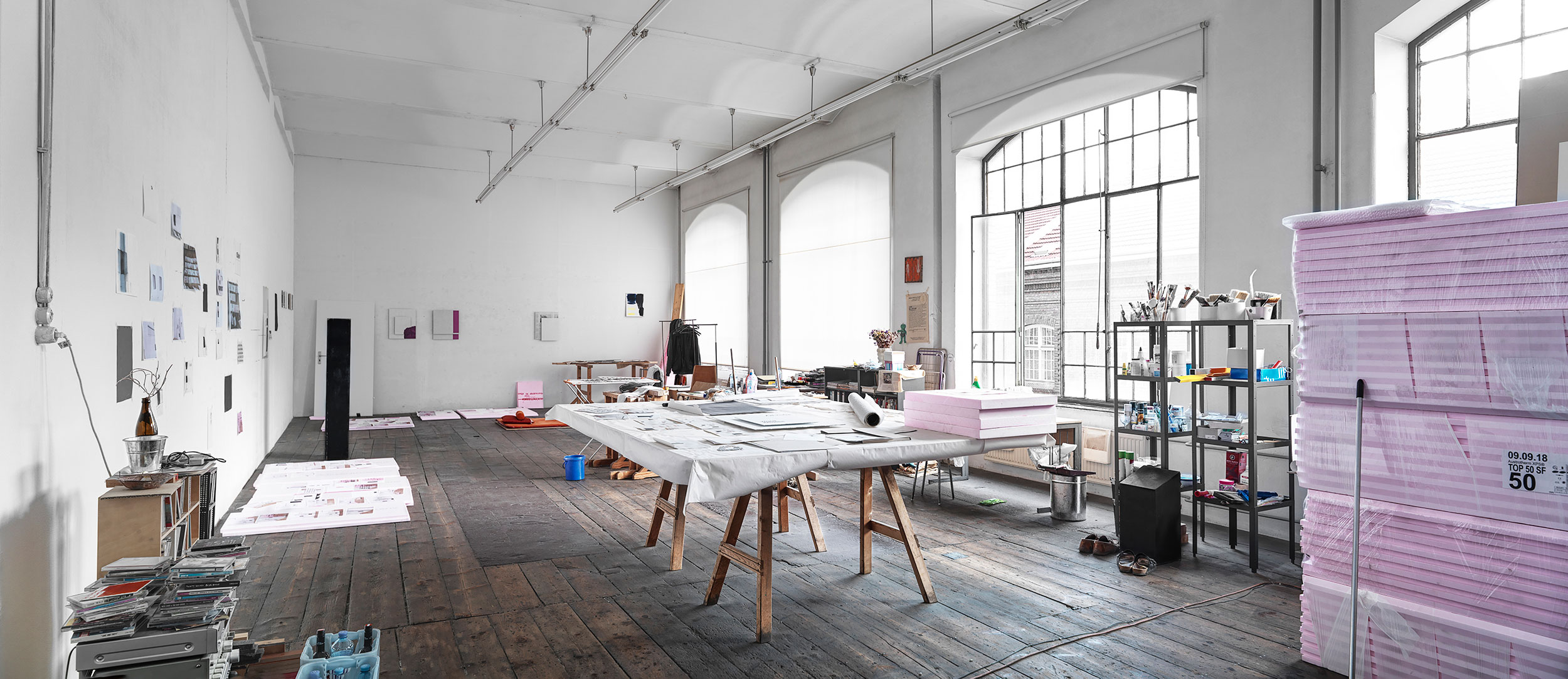 Studio Heinrich Dunst © Sandro Zanzinger
Studio Heinrich Dunst © Sandro Zanzinger
HEINRICH DUNST
Heinrich Dunst combines elements of language, image and sculpture in his works and presents their relationship as medial interfaces. In his “meta-linguistic” spatial interventions and performances, he negotiates the gap between the visible and the sayable, the untranslatability of one form into another, and the contextuality of spatial presentations. The roots of his conceptual approach lie in Concrete Poetry in the Viennese scene of the 1980s with its claim to extend abstract painting into the exhibition space, and also in those artistic positions that, like Marcel Broodthaers, investigate the perceptual systems of word and image. Dunst gives these questions a new topicality by questioning the invoked references in their unambiguousness, ultimately revealing the presuppositions inherent in art. The artist states:
“If the rituals of everyday life, like cans of food, empty themselves incessantly and almost irreversibly in their directed consumption, then they need a double in this ritual: a form that mirrors them. the abstract forms in my works are the volumes for this opposite. For these forms of everyday life. A double. “The tin can becomes stupid, and the abstraction is smart. Perspective reversal: the abstraction becomes stupid, the tin can is clever,” according to Peter Weibel.
The language shift, on the other hand, thematizes this progression and its reversal on a word-linguistic level: these are my performances. The word criticizes the word, through the performative shift of language use. language addresses the emptied ritual of speaking itself.”
Watch the LIVING RITUALS Talk with Heinrich Dunst
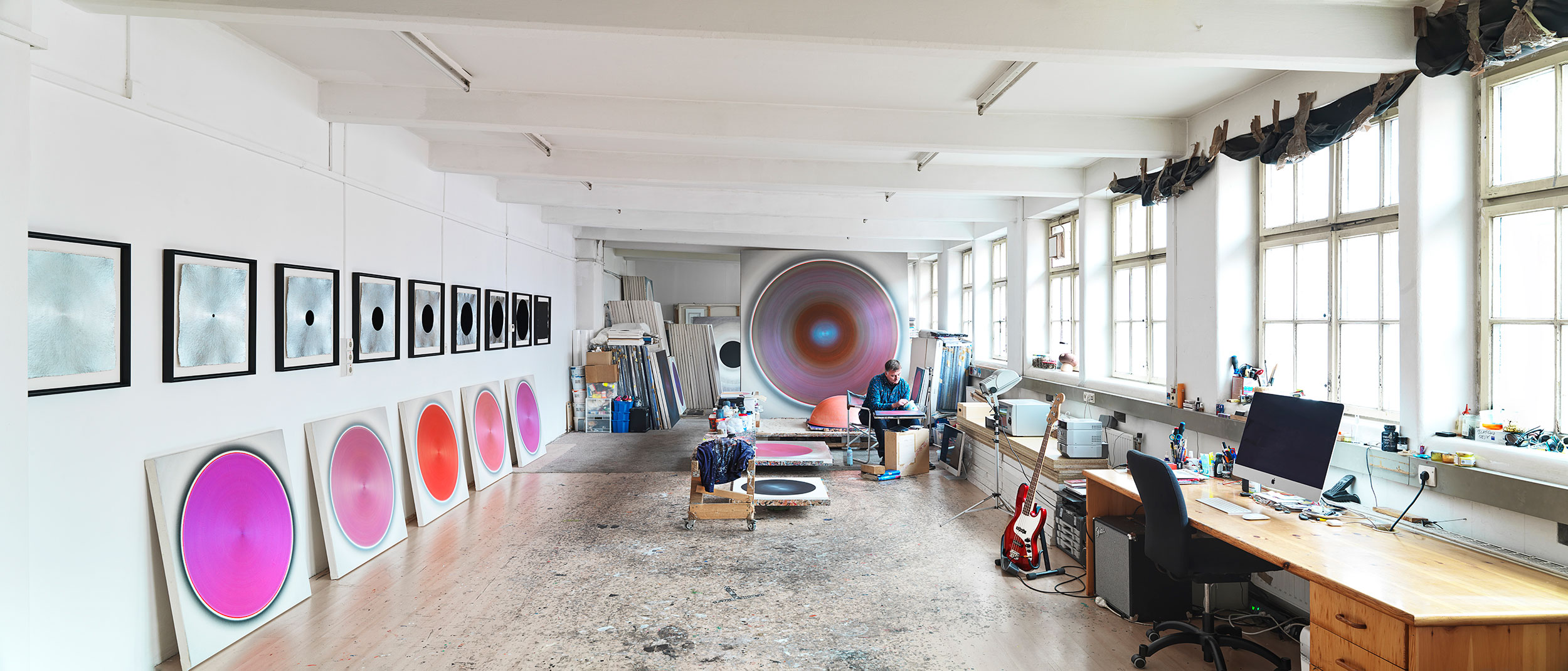 Studio Robert Schaberl © Sandro Zanzinger
Studio Robert Schaberl © Sandro Zanzinger
ROBERT SCHABERL
Auratic images in the literal sense. Central forms, glistening discs that oscillate between punctual concentration in the center and expansion, light reflections and pulsating circular surfaces in infinite color variations, subtle color transitions, sometimes contrasts, but also studies in black. Art of oscillation, which achieves its maximum emphasis in large format and seeks balance in the seriality of medium and small formats. Colored light and the change of the so-called appearance color, that is, the color as the viewer perceives it, is the focus of the work of Robert Schaberl. The spectrum he explores as an Aesthetic Researcher ranges from color as a material to the modulation of microprismatic pigments by the incidence of light. Schaberl creates with his abstract works on canvas and paper, which parry the central perspective by central forms, which are always, barely perceptibly moved from the exact center, painterly spaces of experience, which give the viewer a sensual experience. Depending on the perspective, it appears new.
The repetition of everyday work in the studio, the stretching of the canvases, the mixing of the colors as well as the always same working process, the application of paint in wafer-thin layers, the canvas, which the artist sets in rotation with his hand, the brush, with which numerous circles are formed, Schaberl understands as ritual forms of action.
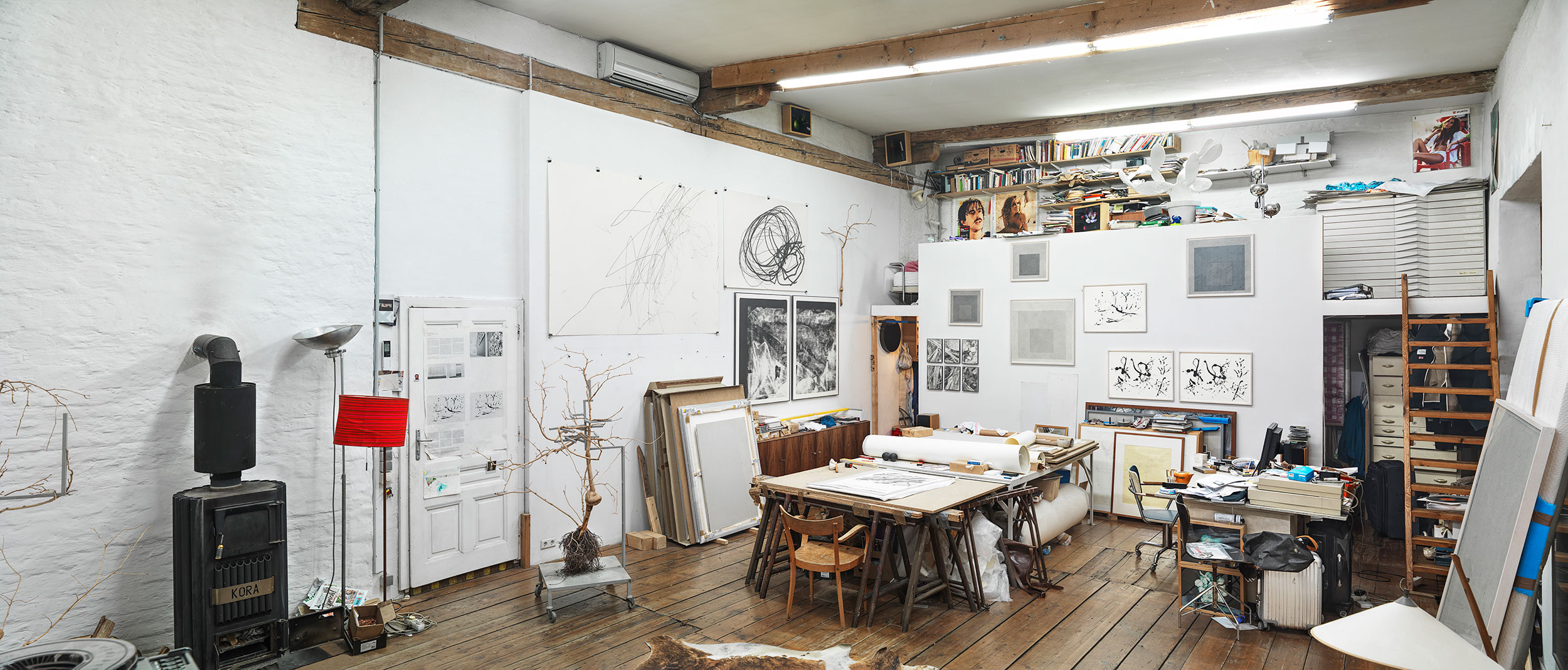 Studio Klaus Mosettig © Sandro Zanzinger
Studio Klaus Mosettig © Sandro Zanzinger
KLAUS MOSETTIG
The basic concept of Klaus Mosettig’s work is the depiction of time through the repetition of the same work processes: Every day he sets his strokes with pencil, hatches for about nine hours and sharpens his tools for about one hour. Whether abstract art, children’s drawings, self-portraits from the art history, imprints that have inscribed themselves in objects and gained socio-political relevance, Klaus Mosettig subjects his chosen motifs to the same procedure over and over again, translating self-chosen originals onto paper using his specific methodology and incorporating them into an archive of forms. By means of this scanner-like activity, flatly depicted artistic emanations, however different they may be, whether art or non-art, can be read similarly. This act of appropriation and homogenization creates a distance to the depicted through the always identical hatching. Questions of authorship, repetition as a meaning-giving element, the formal search for the most convincing, high-quality “stroke” possible, and transparent art production are at the center of Mosettig’s interest. The always uniform, ritualistic activity allows the artist a meditative state of reflection on his work, which can thus – very slowly – develop further.
Watch the LIVING RITUALS Talk with Klaus Mosettig
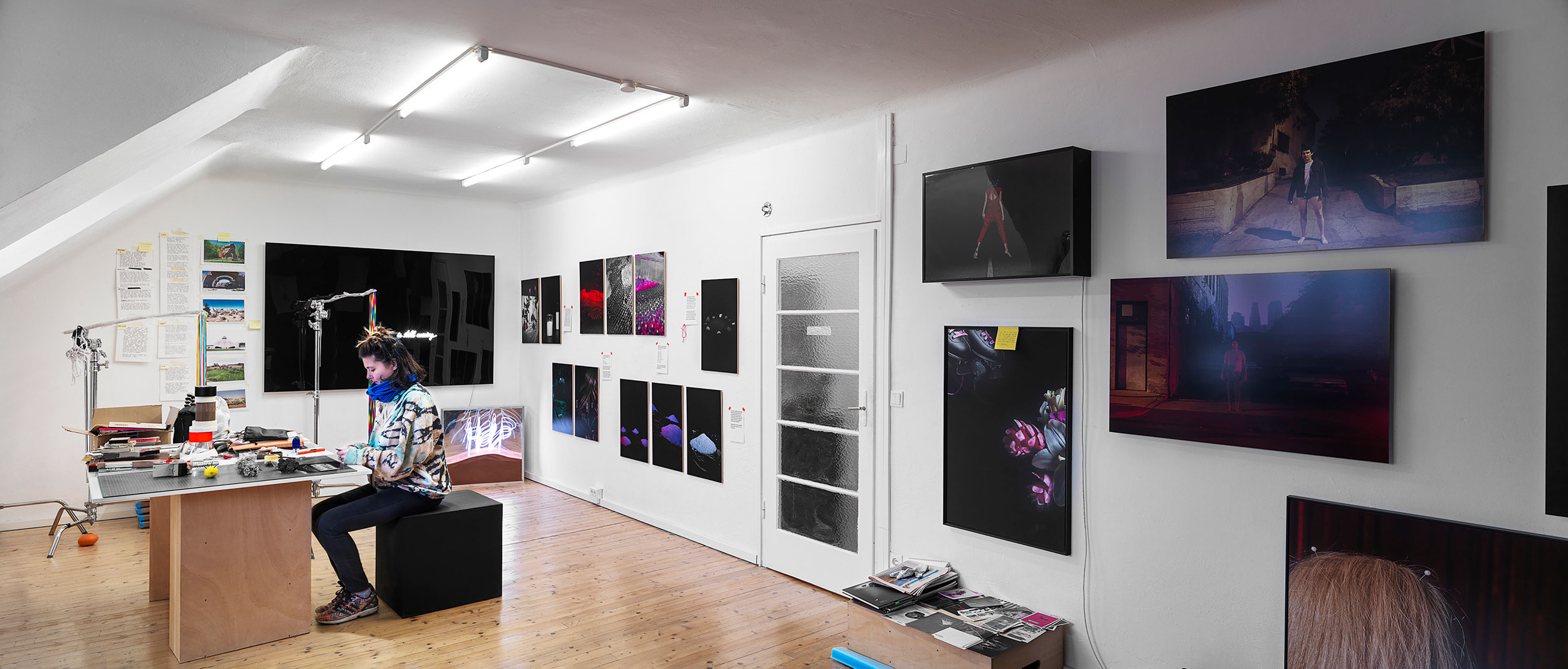 Studio Borjana Ventzislavova © Sandro Zanzinger
Studio Borjana Ventzislavova © Sandro Zanzinger
BORJANA VENTZISLAVOVA
Borjana Ventzislavova works in the fields of film/video, photography, installation and performance. She investigates the relationship between reality and fiction in different social and geographical spaces. In her works she analyzes stereotypes, models of representation, traces the effects of dominant power structures and mechanisms of control in society.
Her work is also concerned with the shifting and transgression of cultural boundaries and the psychological dynamics involved, as well as complex processes of translation. In her artistic practice, she often uses participatory approaches to create a platform of reflection and critique. “Borjana Ventzislavova uses the form of ritual to present, without ideological teachings, the possibility of a social reality constituted by a living, unprejudiced encounter. An idea she shares with the anarchist Pyotr Alexeyevich Kropotkin’s concept of love,” writes Boris Manner. For her, rituals are a technique, an instrument of solidarization and symbolic communication, often with sensual and even supersensual effects. She wants to use them to initiate processes of empowerment and healing. Ventzislavova is concerned with the cultivation and sensitization of the self. The ritual in her work stands for an extra-aesthetic truth. She calls for a new ritual consciousness.
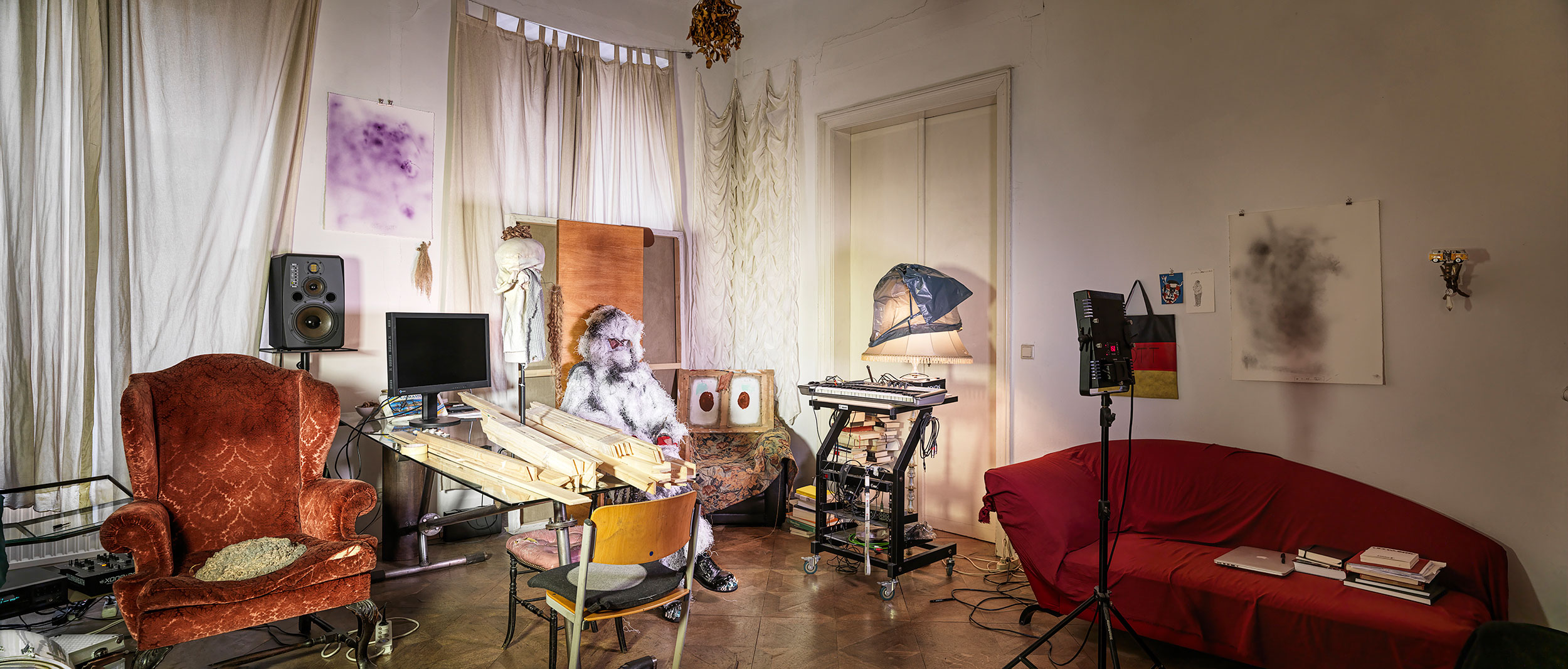 Studio MandreDu Schu © Sandro Zanzinger
Studio MandreDu Schu © Sandro Zanzinger
MANFREDU SCHU
Be ritual, be fact, advises ManfreDu Schu. He deals with body and language, places of beauty and the materialization of the body. He calls his working language “staged visibility.” For him, rituals are an important basic building block in the creation of identity.
“So the spirit is also always body embodied in our most intimate needs,” he says. “Our mirror is the unconscious body that slowly transforms us on a lifelong quest through the confluence of our own identity and the rituals of the outside. The masquerade, the aroused, and the enchanted ceaselessly map us between dream and reality; both are realities of transformation. The source of artistic action is always events and sensations, the stage of the self that leaves the superficial shell of social norms shaped by society. The power of artistic expression must penetrate beneath the mask to reveal the depth of intimacy in a labyrinth that transcends the conflict between the work of art and the self; it turns deep to the interior, to a theatrical analysis of the personality, where something like a transforming truth dwells. In the rite of the experiment dwells the body as spirit and its driving force of conviction; its laboratory is the inner child, whose artistic goal is change, the discovery of the many facets of the self, where life and its effects point to the future in theatrical form as the anatomy of memory.”
Watch the LIVING RITUAL Talk with ManfreDu Schu
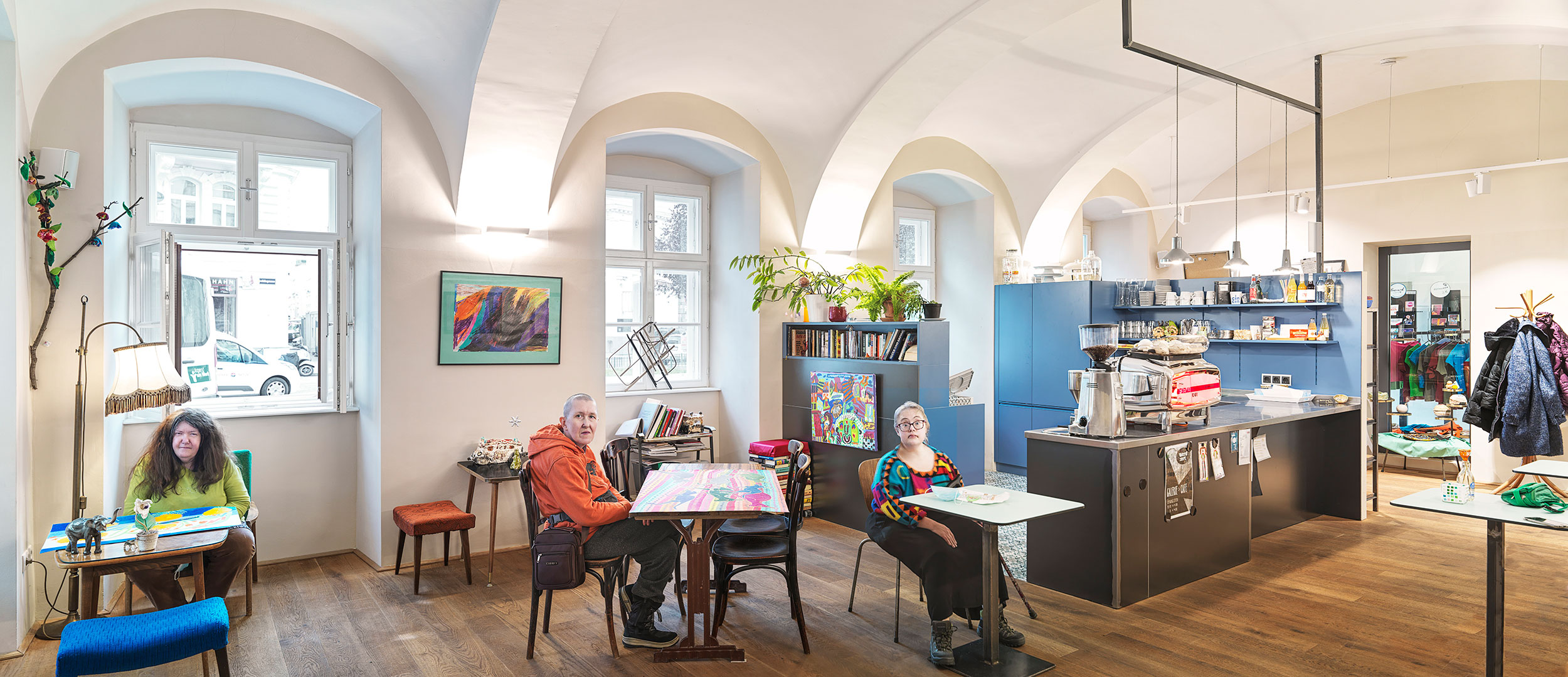 Studio werd:art © Sandro Zanzinger
Studio werd:art © Sandro Zanzinger
SUSANNE DIXON
Suzanne Dixon (born 1972) is interested in past times and distant epochs. Already as a child she encountered (pre-) historical cultural assets through her mother, who is an archaeologist. In particular, she is fascinated by artifacts that were created for representative purposes. Dixon’s figure paintings refer to Austrian aristocratic dynasties from the Baroque, Rococo and Biedermeier periods as well as to contemporary heads of state and cities. The focus of the colored and felt-tip pen drawings in DIN A4 and A3 formats, which look like display panels in a museum, is on female rulers, their ornamentally decorated robes, accessories, and utensils: this ranges from an electress to a margravine to a backyard Madonna. Mostly her head is crowned. The design of the colorfully patterned dresses is reminiscent of the artist’s small-format embroideries in their detailed execution and precise placement of dots and color areas, which she collected in an artist’s book accompanied by brief comments. They often show small scenes with people and especially animals. Emotional expressions and wishful thinking complement the textile little pictures.
SUSANNE KUZMA
Susanne Kuzma (born 1966) paints landscapes with colored pencils in colors that make you happy. The artist abstracts from photographic models that inspire her, for example by dissolving horizon, meadow and field into stripes, rainbows and colorful checkerboard patterns. The ultimately representational images are constructed from squares, motivic repetitions and geometric shapes. Landscapes, fields of flowers, beaches, ornamental pattern images that emphasize the surface are created. Clouds resemble scribbles with color gradients, nature is alienated, stylized and fantastically exaggerated: Flowers, trees, and animals seem to spring from a free realm of the imagination and bear only a vague resemblance to reality. Kuzma follows an artistic program dedicated to beauty. Her schematized forms are indebted to an unaffected approach. Nevertheless, it is not Kuzma’s goal to depict a harmony of order; instead, she repeatedly stages mistakes and rule-breaking. The rehabilitation of ritual can also be encountered in contemporary art in the emphasis on form as the ethic of ornamental aesthetics.
INGRID LECHNER
Frogs, parrots, owls, butterflies and chameleons are typical pictorial motifs of Ingrid Lechner (1972). Embedded in a fauna shimmering in many shades of green, an exotic animal world gathers in the works on paper, animalistic fantasy creatures and predators that have wings proudly present themselves under a sky of colorful garlands. Lechner depicts a horde of ordinary house cats in front of a wallpaper of hearts. One time as a mass, the other time neatly arranged or lined up in rows. Before she begins to work, Lechner studies books and photographs and then translates the representations she has selected into a two-dimensional formal language. The realistic depiction of reality has never been of interest to the artist. With the pronounced ornamentation, the shrill swirls of color that often dynamize the static composition, the works often have a psychedelic feel. The interweaving of colors and forms dominates the colored pencil drawings just as much as the focus on animal depictions. Lechner wants to undermine conventional pictorial orders and repeatedly turns the picture support during the working process in order to relativize the hierarchies of above and below, left and right.
(Texts: Angela Stief)
An insight into the wer:art – Studio here!
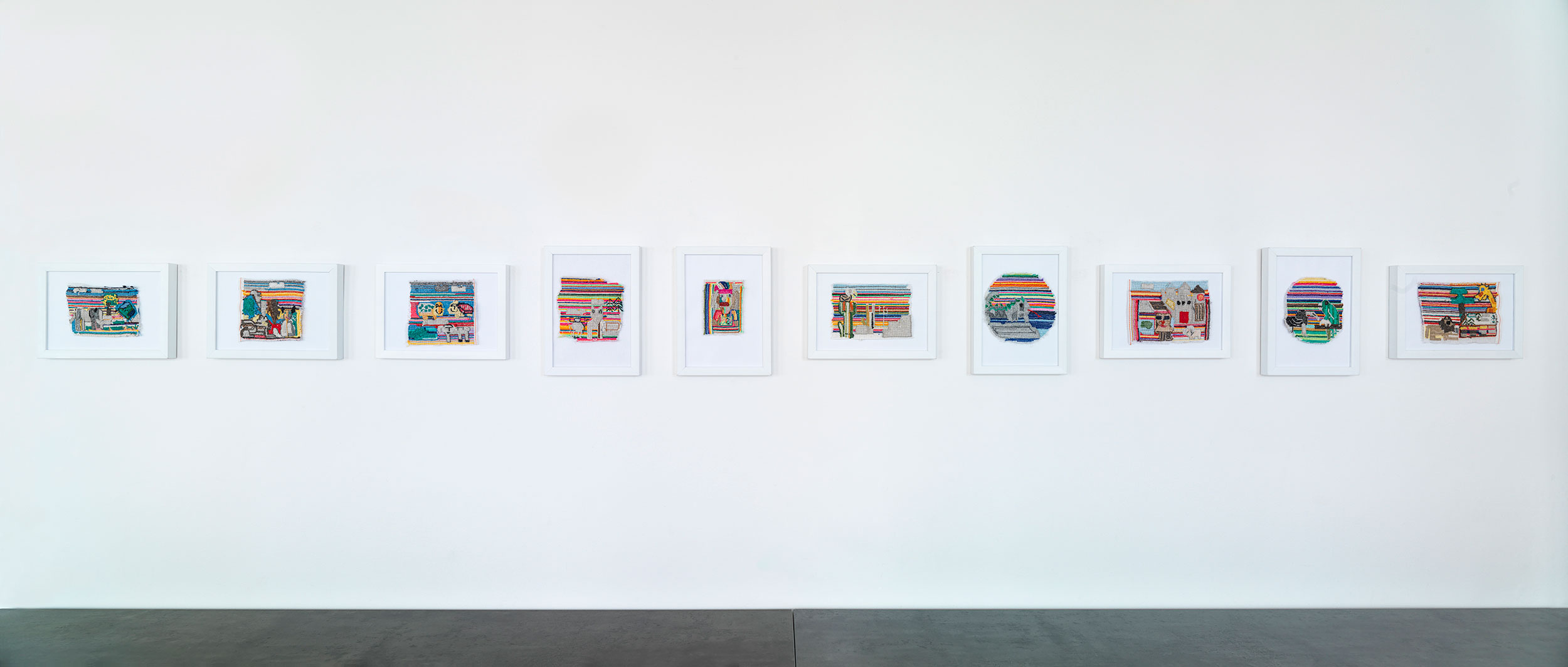
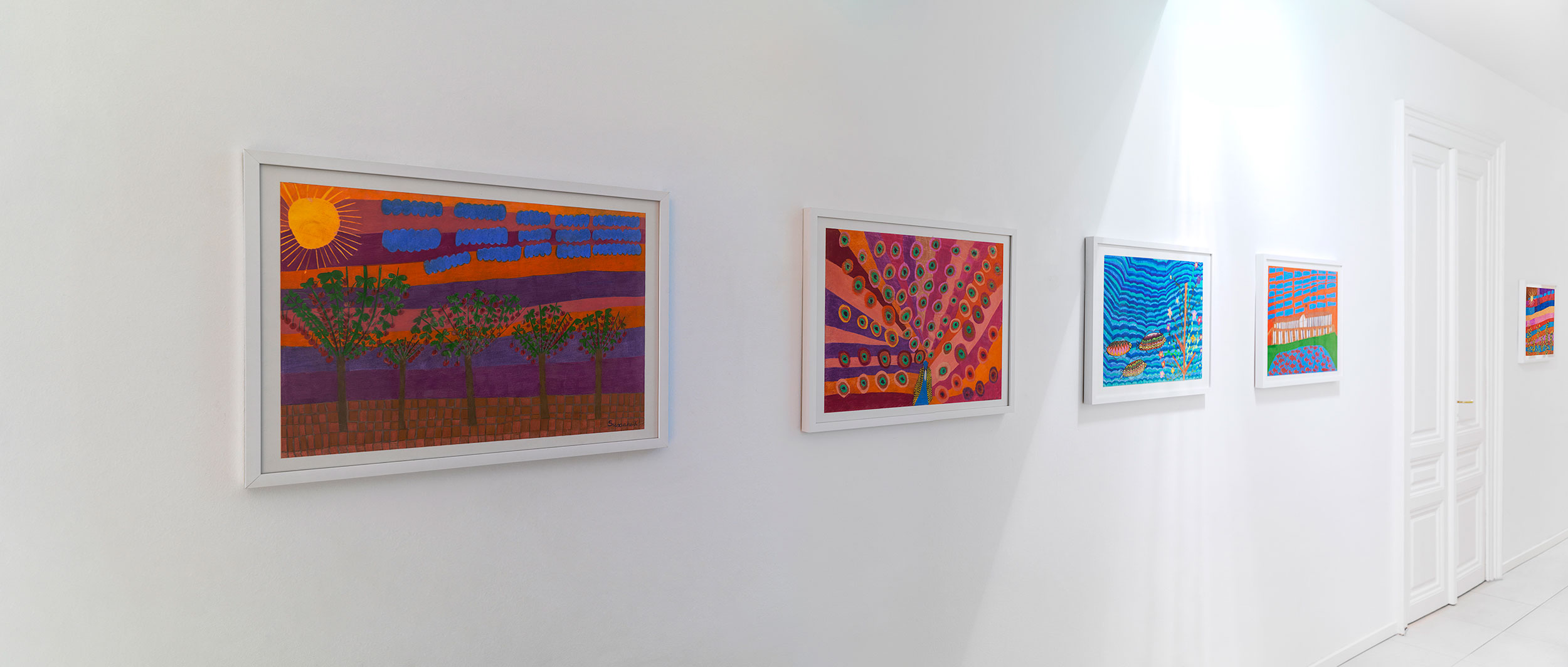
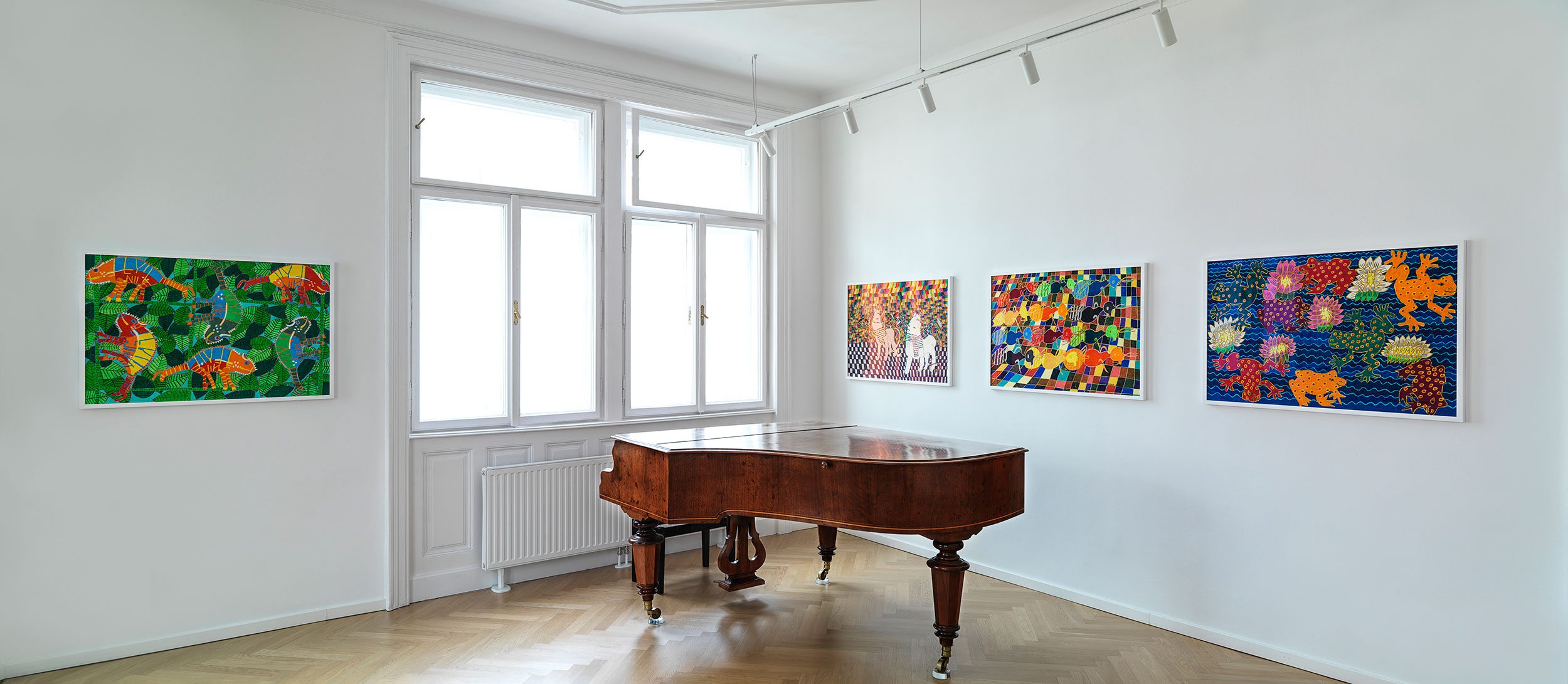
 and then
and then